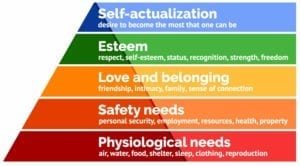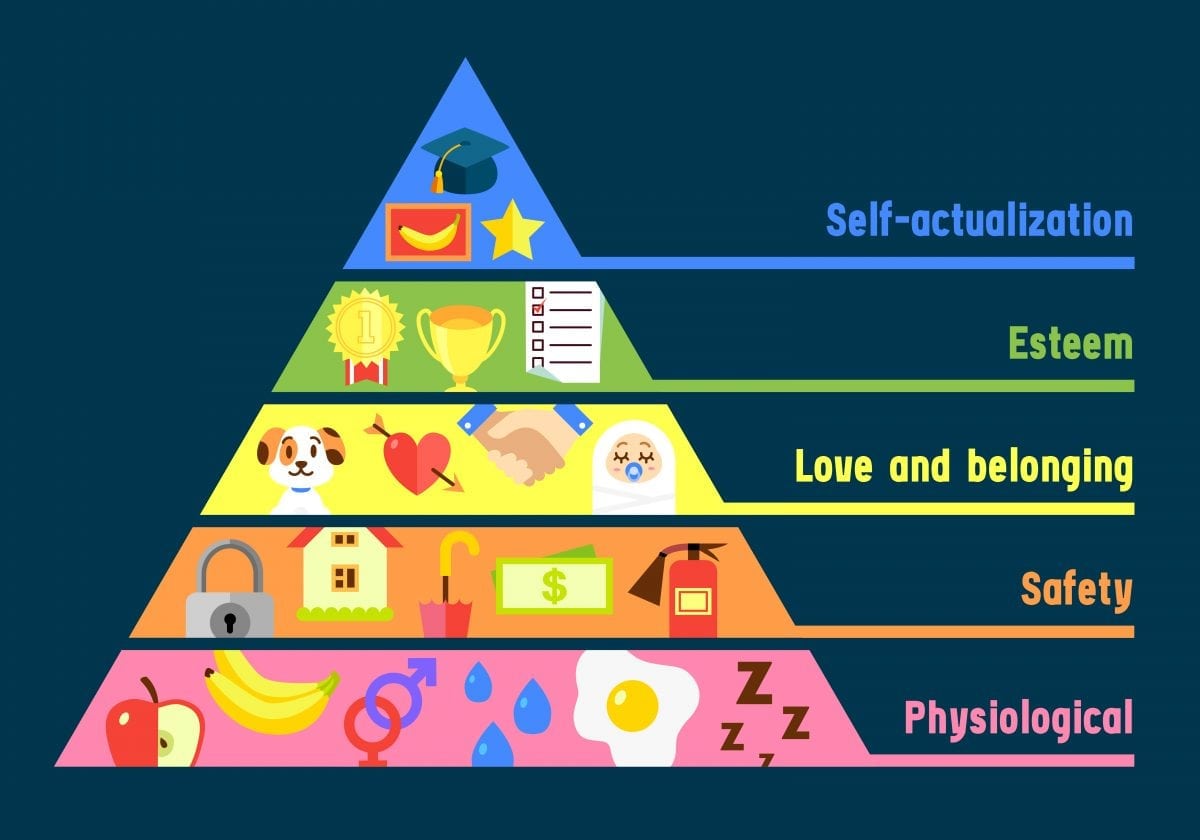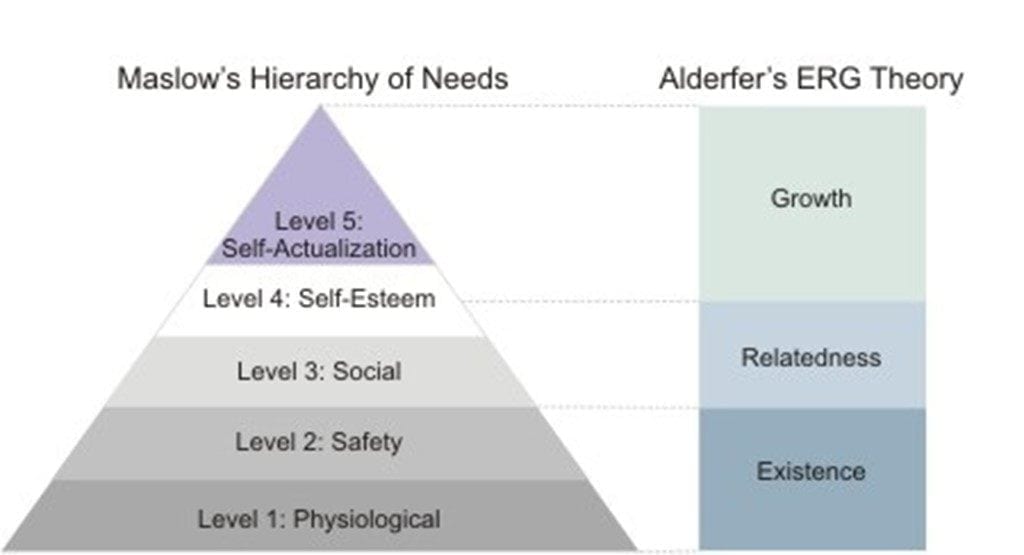For many years, psychologist and theorists alike have wondered, why does man do what he does? Why does a certain action take place? What is the motivation to perform a certain act? Finally, a psychologist, Clayton P. Alderfer answers these complicated questions with his ERG Theory.
Clayton P. Alderfer’s ERG Theory comes under the very intriguing topic of Motivation in Psychology. It is a rather well known theory in the topic of theories of motivation, and more specifically, it’s Content Theories. Commonly, this theory goes hand in hand with Abraham Maslow’s Theory on the Hierarchy of Human Needs, as it is a condensed form of it. However, there are certain differences to the ERG and The Hierarchy of Human Needs Theory.

Maslow’s Theory vs. Alderfer’s Theory
1) Abraham Maslow’s Hierarchy of Human Needs Theory:
Before Clayton P. Alderfer, another American Psychologist, Abraham Maslow, explained the causes for behavior, or the motivation to perform: Basically, Motivation results from a demand of a need to be satisfied, and the act or performance it takes to satisfy that need is behavior. So, Maslow bought forward a theory called “The Hierarchy of Human Needs”, through which he explained, using a pyramid, that humans have five levels or stages of needs. The lower most stage is the most essential and demanding, followed by the one above, and so on. According to this theory, a person cannot satisfy a need if the one below it is left unsatisfied.
The stages in Maslow’s Pyramid includes:
- Physiological or Basic Needs.
- Safety Needs.
- Social Needs.
- Esteem Needs.
- Self-Actualization Needs.

The first stage, Physiological or Basic Needs, includes all the survival needs for a human, i.e. Food, water, shelter, sleep, excretion, etc. This need is the most demanding.
The second stage, Safety Needs, includes the need of an individual to feel secure and protected, i.e. need for security, laws, order, etc.
The third stage, Social Needs, includes the need of the whole human race for social interactions, i.e. Relations with other, intimacy, belonging need, etc.
The fourth stage, Esteem Needs, includes external esteem as well as internal esteem, i.e. self-confidence, high sense of self, respect from others, good reputation, etc.
The fifth and last stage in Maslow’s Pyramid is Self-Actualization Needs. This includes all personal growth needs where the person can recognize their potentials and accomplish them.
The first four stages are categorized as Deficiency Needs by Maslow, while the fifth is categorized as a Growth Need. Deficiency Needs basically refer to those need in which the absence of their satisfaction leads to anxiousness in a person.

2) Alderfer’s ERG Theory:
As said above, Clayton P. Alderfer’s ERG Theory is a condensed or concentrated form of Maslow’s Need Structure. Here, Alderfer has condensed Maslow’s five stages in just three: Existence Needs, Relatedness Needs and Growth Needs. The term “ERG” in the name of his theory refers to these three elements.
The first need in Alderfer’s theory is Existence Needs. This is basically a compilation of Maslow’s first two needs, i.e. Physiological or Basic Needs and Safety Needs. It includes all the factors which are necessary for human survival like: Food, water, shelter, air, sleep, excretions, safety and security, etc.
The second need in Alderfer’s theory is Relatedness Needs. This is basically a compilation of Maslow’s Social Needs as well as a part of Esteem Needs. It includes factors such as: Need to establish bonds with others, to belong in a group, respect from others, good reputation, etc.
The third and last need in Alderfer’s theory is Growth Needs. This is basically a mixture of Maslow’s Self-Actualization Needs as well as a part of Esteem Needs. This need is basically related to one’s internal and personal growth of potentials and a high sense of self.

- The difference between both these theories is that in Maslow’s Pyramid, an individual has to satisfy the lower level needs before they can start on the higher levels. According to Maslow, only one level of need can be satisfied at a time. However, according to Alderfer and his theory, multiple needs can be satisfied at the same time.
- Another difference between the two theories is that in Maslow’s theory, for each individual, the pyramid is built on the same Need sequence. While in Alderfer’s theory, the need order (higher-level and lower-level needs) can differ from each person to person. For example: an artist may put his Growth Needs before his Relatedness Needs.
Satisfaction Relationships in Alderfer’s ERG Theory:
There are three types of satisfaction relationships in Clayton P. Alderfer’s ERG Theory. They are as follows:
1) Satisfaction-Progression:
The first type of relationship in Alderfer’s theory is Satisfaction-Progression. This basically refers to satisfying a need and moving on to higher-level needs. In Maslow’s Hierarchy of Human Needs Theory, the whole process revolves around this relationship as according to Maslow, a person cannot move up to a higher-level need without satisfying the lower level need. However, in Alderfer’s theory, this is not the case. Here, if a person moves from satisfying his Relatedness Needs to his Growth Needs, it does not necessarily mean that his Existence Needs are satisfied.
2) Frustration-Regression:
The second type of relationship in Alderfer’s theory is Frustration-Regression. This basically refers to when a person is unable to satisfy a higher-level need, they may regress to lower-level needs as they appear to be easier to satisfy. This relationship suggests that an already satisfied need can resurface and once again become active, if the need above it remains unfulfilled.
3) Satisfaction-Strengthening:
The third and last type of relationship in Alderfer’s theory is Satisfaction-Strengthening. This basically refers to satisfying a current level of satisfied need again and again. This relationship suggests that a current level of need can be satisfied again and again when the individual fails to satisfy a higher-level need.
In conclusion we can say that Clayton P. Alderfer’s ERG Theory is a condensed form of Maslow’s Hierarchy of Human Needs Theory. Apart from being concentrated, it challenges and solves all the criticisms Maslow’s Needs Theory had faced.





